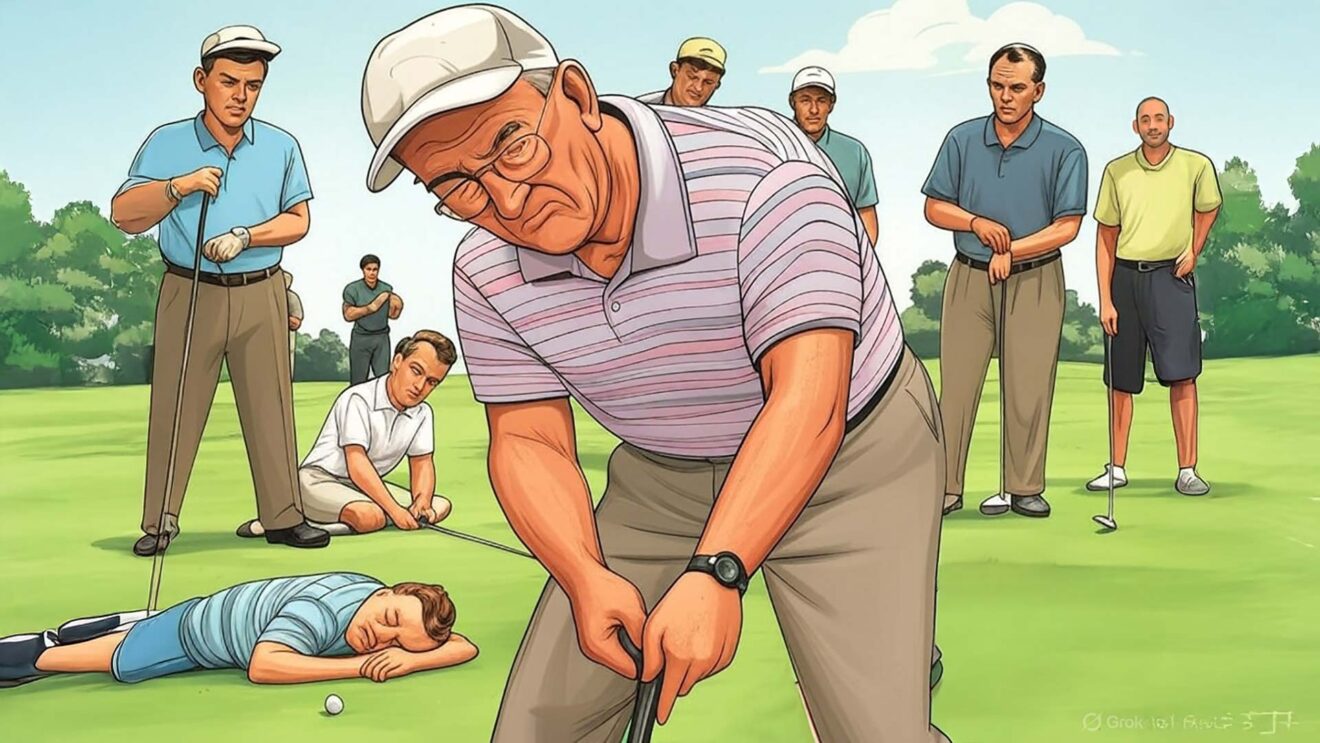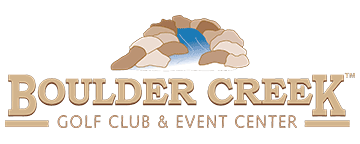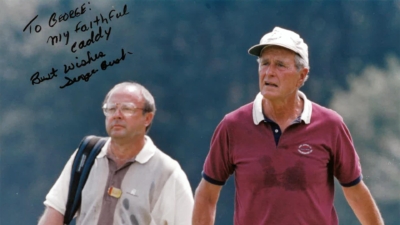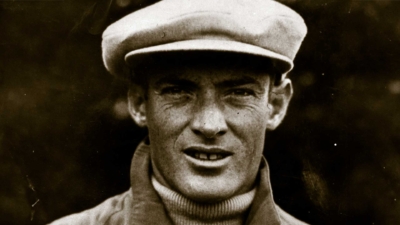This story first appeared in the Fall 2024 edition of Northern Ohio Golfer Magazine, the official print publication of the Northern Ohio Golf Association. NOGA members who provide a mailing address in their GHIN account receive a copy mailed to their home twice per year. Not yet a NOGA member? Join for 2025 now!
A personal rant on golf’s soul-crushing pace of play
I am a pretty fast golfer.
I’m not one of those guys who brags about running 9-holes in an hour. Nor am I someone who wakes up at 5:30 a.m. on a Saturday to get the first tee time so no one goes out before me. Neither of those options sound fun.
But I can walk nine holes with my old-man push cart in under an hour and a half. And if you put me in a riding cart with three other guys who know how to move and no one in front of us, an 18-hole round played in three hours feels like the proper pace.
Because it is.
I have played pretty fast since I was 13 years old, from my caddie days at Elyria Country Club in the early 1980s. Many of the good players at that club played pretty fast, too.
For years, playing at a brisk pace was common. Golf was a niche game and courses were not too busy. Even after the growth gained from the Tiger Woods era, golf still had some motion to it.
But now, especially after the COVID boom, finding that much open space in front of you on a golf course is nearly impossible, even at a private club. Standing around on the tee and then standing around again in the fairway is all too common.
So for the most part, I stick to playing scratch tournaments as my primary on-course time now. I’ll hit a few balls at the range or chip-and-putt around a green on the days between those events.
Much to my chagrin, the pace of play at those competitive scratch golf tournaments – filled exclusively with players of far better-than-average skill! – keeps getting slower and slower, too.
What the heck.
LET’S IDENTIFY THE PROBLEM
The problem is self-evident: most golfers either don’t know how to play at a decent pace or don’t want to play at a decent pace.
I’m not scolding beginners here; they’re just learning. As long as newbies play at a course suited to their skills and skip the prime tee times on prime days, let’s leave them alone. Yes, play as fast as you can. Yes, pick up when you need to catch up to the group in front. Yes, spend way more time at the range learning how to get the ball airborne before heading to the course. But play, keep up, have fun.
The golfers deserving of a scold have been playing for years and still take more than four hours to finish a round. They are the scourge.
Playing golf at a reasonable pace requires only two things: common sense and self-awareness. The steps required to play fast are easy to understand and accomplish.
Know how to move around a golf course and be aware of your position on it. Hit your ball, find it, hit it again. Then find it and hit it again. Don’t rush, don’t run, but move along.
Watch closely when your ball is flying someplace crazy, and mark its location with a tree, a bush, or a rock so you know exactly where to look.
Get your yardage and read your putt without making a show of it. Do those things before it’s your turn, not when it is your turn: no one wants to watch another player plumb-bob or aim-point or take six practice swings.
If you’re in a cart, be it driver or passenger, get out of the cart and walk to your ball if it is ahead of your cart partner’s. Take over the cart-driving duties if you are away, so the long-knocker can hit right after and be picked up. Then drive up and do it again, leaving the cart positioned toward the green or the next tee each time.
Whether you are away or not, if there is no one standing directly in front of you and you are ready to hit, then hit.
Know where your ball is, know where the other players in your group are, and keep moving.
Golf is a sport. Some blood should flow. All of these things are easy to do. Collect your data, make a decision, pull a club, then two-dribbles-and-shoot. Anything different from that process leads to doubt, which leads to poor play.
Oh yeah, one more thing: save that hilarious story you have to tell the group until after the round, when you sit down for a beer. It will be much funnier in the clubhouse than on the tee box.
THERE’S A BIGGER WORLD OUT THERE THAN YOU
After hearing what I’ve outlined above, some golfers will inevitably respond, “Well, I just want to come out and relax and enjoy the day. I don’t want to play too fast.”
That kind of self-centered thinking makes my head explode. In essence, you believe your feelings of personal enjoyment are more important than that of any other person behind you on the golf course that day. Sorry, brothers and sisters, they are not.
No player on the course behind you expects you to rush or run between shots. But it IS fair for everyone behind you to expect that you will focus on playing golf, that you will play at a reasonable pace, and that you will not turn everyone’s round into a park visit where bird watching and yoga stretches are required to kill time.
ALSO COUNTING ON THE BOSS MAN
Golf course owners, pros, and GMs, a fair portion of these ever-worsening pace of play problems are your direct responsibility, too.
First, it is up to you to make sure the number of minutes between tee times on your starter’s sheet match the reality of your golf course. No 7-minute revenue grabs; set a reasonable gap. 10 minutes between tee times is a nice round number and makes the starting time easy to remember.
Since courses are packed nearly every day now, you must have plenty of competent starters and rangers on the course at all times, every day of the week. Those employees must have the training they need to keep players moving. Having a ranger on each nine at the same time is a pretty good idea, too.
Starters need to suggest moving up to the proper tees to as many players as possible, as often as possible. That alone can make or break the day.
Finally, you must create a noticeable pace-of-play system for your course, with objective metrics and conspicuous time displays. That way, players know when they fall behind and by how much, and rangers have some ammo when they start their “would you mind” conversations. (By the way, any golf course that says their “time par” is over 4:15 is normalizing slow play. Instead of encouraging that, fix the cause.)
THE MOST FRUSTRATING GROUP OF ALL
The final portion of my slow play rant is aimed at my low-handicap tournament golfer friends, the players who should know best of all.
I played in many tournaments this past year where the only people on the golf course were the scratch players who made up the field. There were no unwashed hacker masses in front of us to blame for holding everybody up. Yet it still took five-plus hours to play in a handful of tournaments.
A field of scratch players taking more than 4:15 on almost any golf course is inexcusable. It’s a problem that must be resolved by both the players and the tournament directors.
Players need to remind each other to keep moving. It’s not insulting to say, “Hey, we’re falling behind.” Or, “That’s three minutes looking for your ball, time to move on.” If necessary, make a joke about it, but say something when play starts dragging.
From the tourney director’s side, the pace of play must be addressed with constant, visible monitoring, quick out-of-position warnings, penalty shots, and removing players from the golf course if necessary. A one-time show of force is an awesome deterrent, and nothing will change without making it change.
DON’T BE THAT GUY
With all my years of playing, I’m sure I have blacked out and fallen into one of the slow-play traps I’ve just described. It’s easy to let your brain get too far into the game, to start overthinking, and then take too long to hit.
The fix: snap out of it! It’s a choice to play slow or fast. The game requires a sense of personal responsibility from every single player to make it fun for every single player. If a five-hour round doesn’t bother you to your core, well, we can’t be friends.
Golf is one of the very few games where, by its nature, the players stack up behind each other like airplanes on a runway, forced to wait on the one in front before taking a turn. If one group goes slow, all groups go slow, no matter what. Just think about that every time you play.
Playing at a decent pace is a personal responsibility owed to every other golfer on the course. Just hit it, find it, hit it again, and keep moving. That’s when golf is fun.
Have an opinion on another golf topic that readers might find interesting? Send an email with your words of wisdom to golf@northernohio.golf an we may publish it to the website or magazine.













































